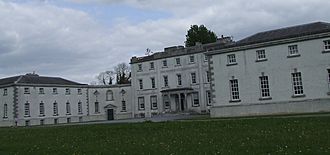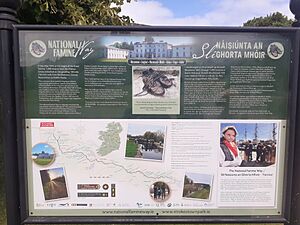Strokestown Park facts for kids
Quick facts for kids Strokestown Park |
|
|---|---|

Strokestown Park House in 2011
|
|
| General information | |
| Architectural style | Palladian |
| Town or city | Strokestown |
| Country | Ireland |
| Coordinates | 53°46′37″N 8°06′14″W / 53.777°N 8.104°W |
| Current tenants | National Famine Museum |
| Completed | 1730 |
| Renovated | 1820 (portico added) |
| Technical details | |
| Material | limestone |
| Design and construction | |
| Architect | Richard Cassels |
| Developer | Thomas Mahon MP (1701-82) |
Strokestown Park House is a grand historic house in Strokestown, County Roscommon, Ireland. It is built in a style called Palladian, which was popular in the Georgian era (1714-1830) and known for its grand, symmetrical designs inspired by ancient Roman temples. The house sits on a large estate of about 300 acres (120 ha).
Today, the house and its beautiful grounds are open for people to visit. The old farm buildings on the estate are now home to the important National Famine Museum, which tells a key part of Ireland's history.
Contents
The Story of Strokestown Park
For over 300 years, from the 1600s until 1981, Strokestown Park was the home of the Mahon family. They were a powerful family with a history of serving in the military.
The Mahon Family Home
The family's story at Strokestown began in the 1660s. A soldier named Captain Nicholas Mahon was given thousands of acres of land in County Roscommon. His son, John Mahon, finished building the first house on this land around 1696. It was likely built on the ruins of an even older castle.
Over the years, the Mahon family became very wealthy and powerful. By the early 1700s, their estate covered over 11,000 acres (4,500 ha). Maurice Mahon, a later family member, bought even more land and was given the title Baron Hartland in 1800.
A Dark Time: The Great Famine
The Great Famine (1845-1852) was a terrible period of starvation and disease in Ireland. During this time, many poor tenant farmers who lived on the Strokestown estate could not pay their rent. The Mahon family forced thousands of people to leave their homes. In 1847 alone, they evicted 3,000 people.
The head of the family at the time, Major Denis Mahon, was killed in November 1847. This happened after many people from his estate died on ships bound for Canada, which were meant to be a form of escape but were often unsafe.
After this, his daughter Grace Catherine Mahon vowed never to live at Strokestown again. She had just gotten married, and her marriage to a wealthy man helped save the estate from going bankrupt. Even with more money, the family continued to clear land of its tenant farmers.
Changes in the 20th Century
In the early 1900s, the government began to buy large amounts of land to help poor farmers. In 1911 and 1912, a government group called the Congested Districts Board for Ireland bought over 8,600 acres of the Strokestown estate. The land was then divided up and given to local families to create smaller, more manageable farms.
The Mahon family continued to live at Strokestown Park until 1981, when the last family member, Olive Pakenham Mahon, left the house. Since 1979, the estate has been owned by a local company called the Westward Group.
Bringing the Estate Back to Life
Over the years, a lot of work has been done to restore Strokestown Park to its former glory.
The Walled Gardens
In 1997, the beautiful 4-acre (1.6 ha) walled pleasure garden was carefully restored. It was officially reopened by Mary Robinson, who was the President of Ireland at the time. These gardens are a peaceful place filled with historic plants and flowers.
A Modern Visitor Attraction
In 2022, the main house and the National Famine Museum were reopened after a major restoration project. While the estate is still privately owned, it is now managed by the Irish Heritage Trust, a charity that protects important historic sites in Ireland. This ensures that Strokestown Park will be cared for and enjoyed by visitors for many years to come.
The National Famine Museum
The old buildings of the Strokestown estate are now home to the Irish National Famine Museum. This museum holds one of the best collections of original documents and records from the Great Famine.
All the letters, rent books, and maps on display are from the Strokestown estate itself. They provide a unique and personal look at what life was like for both the landlords and the tenants during this tragic time. The museum helps visitors understand the causes and effects of the Famine in Ireland and connects this history to issues of hunger in the world today.


